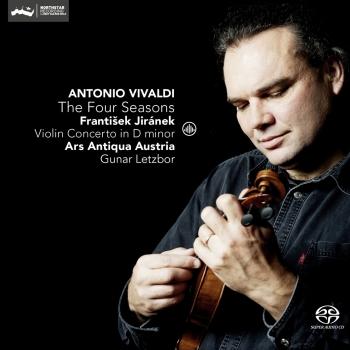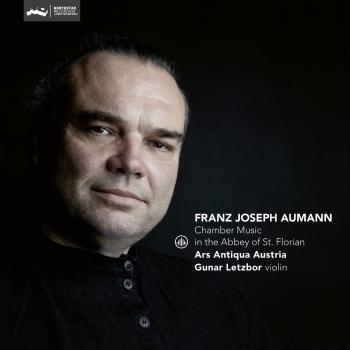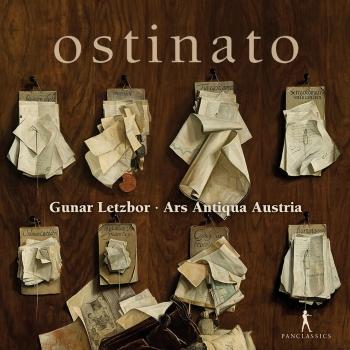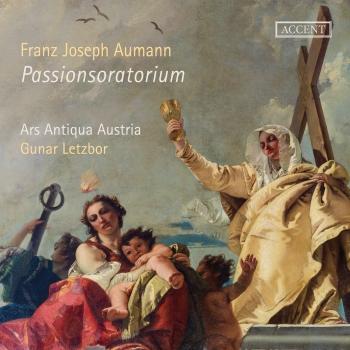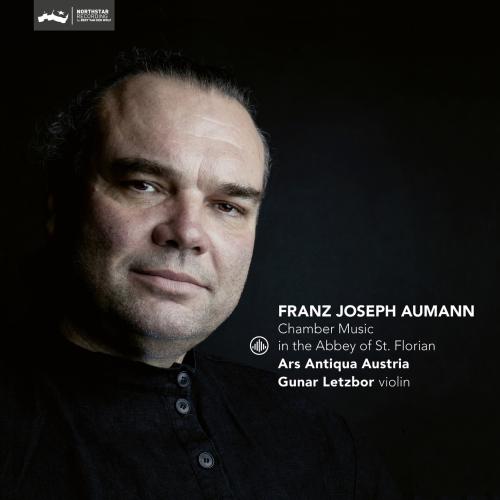
Chamber Music in the Abbey of St. Florian Ars Antiqua Austria & Gunar Letzbor
Album info
Album-Release:
2022
HRA-Release:
11.01.2022
Label: Challenge Classics
Genre: Classical
Subgenre: Chamber Music
Artist: Ars Antiqua Austria & Gunar Letzbor
Composer: Franz Josef Aumann (1728-1797)
Album including Album cover Booklet (PDF)
- Franz Joseph Aumann (1728 - 1797): Parthia ex G a 5 Stromenti Violino Primo, Violino Secondo, Viola Prima, Viola Seconda con Violone:
- 1 Aumann: Parthia ex G a 5 Stromenti Violino Primo, Violino Secondo, Viola Prima, Viola Seconda con Violone 03:41
- 2 Aumann: Parthia ex G a 5 Stromenti Violino Primo, Violino Secondo, Viola Prima, Viola Seconda con Violone: Menuet 04:03
- 3 Aumann: Parthia ex G a 5 Stromenti Violino Primo, Violino Secondo, Viola Prima, Viola Seconda con Violone: Andante 04:30
- 4 Aumann: Parthia ex G a 5 Stromenti Violino Primo, Violino Secondo, Viola Prima, Viola Seconda con Violone: Finale 01:47
- Cassatio in D a 2 Violini, Flautello concertato, Alto Viola e Violoncello:
- 5 Aumann: Cassatio in D a 2 Violini, Flautello concertato, Alto Viola e Violoncello: Allegro 02:16
- 6 Aumann: Cassatio in D a 2 Violini, Flautello concertato, Alto Viola e Violoncello: Menuet - Andante 04:32
- 7 Aumann: Cassatio in D a 2 Violini, Flautello concertato, Alto Viola e Violoncello: Andante - con sordino 03:56
- 8 Aumann: Cassatio in D a 2 Violini, Flautello concertato, Alto Viola e Violoncello: Menuet - Allegro 02:00
- 9 Aumann: Cassatio in D a 2 Violini, Flautello concertato, Alto Viola e Violoncello: Finale 01:25
- Cassatio ex C a 2 Violini, 2 Viole e Basso:
- 10 Aumann: Cassatio ex C a 2 Violini, 2 Viole e Basso: Divertimento - gustoso 04:02
- 11 Aumann: Cassatio ex C a 2 Violini, 2 Viole e Basso: Menuet 03:56
- 12 Aumann: Cassatio ex C a 2 Violini, 2 Viole e Basso: Andante - con sordini 04:35
- 13 Aumann: Cassatio ex C a 2 Violini, 2 Viole e Basso: Finale - Presto 01:45
- Franz Joseph Aumann:
- 14 Aumann: Die Hex 02:47
- Divertimento in B a 5 Stromenti Violini 2, Alto Viole 2 e Violone:
- 15 Aumann: Divertimento in B a 5 Stromenti Violini 2, Alto Viole 2 e Violone: Allegro 02:44
- 16 Aumann: Divertimento in B a 5 Stromenti Violini 2, Alto Viole 2 e Violone: Menuet 04:48
- 17 Aumann: Divertimento in B a 5 Stromenti Violini 2, Alto Viole 2 e Violone: Andante 02:57
- 18 Aumann: Divertimento in B a 5 Stromenti Violini 2, Alto Viole 2 e Violone: Finale - Presto 01:35
- Parthia in C a Violinis 2, Alto Viola, Clarinis 2, Basso* con Tympano:
- 19 Aumann: Parthia in C a Violinis 2, Alto Viola, Clarinis 2, Basso* con Tympano: Presto 03:28
- 20 Aumann: Parthia in C a Violinis 2, Alto Viola, Clarinis 2, Basso* con Tympano: Menuet 02:36
- 21 Aumann: Parthia in C a Violinis 2, Alto Viola, Clarinis 2, Basso* con Tympano: Andante - sempre piano 04:07
- 22 Aumann: Parthia in C a Violinis 2, Alto Viola, Clarinis 2, Basso* con Tympano: Finale - Tempo di Menuetto 01:50
Info for Chamber Music in the Abbey of St. Florian
Gunar Letzbor: Franz Josef Aumann was born in the Austrian town of Traismauer in 1728 and studied music in Vienna, where he came across many important musicians of his time. It has not yet been established why in 1753 he relocated to Sankt Florian. He must have been unusually talented, as two years later he became Regens Chori, one year before his ordination to the priesthood. From that point he remained in the service of the monastery until his death in 1797. He composed “entertainment” music of the highest quality – pieces that were played for the amusement of invited guests, on special occasions, or simply between the various courses of lavish banquets. In the archives of St Florian Monastery not many chamber works have survived – only a handful, but these are of outstanding quality. The quintets are remarkable. Here the master develops a particular style of chamber music: two violins are juxtaposed with two violas. Both groups of instruments have equal status and enter into a lively discourse. Aumann mastered all the compositional techniques of his time. We can, however, observe a particular preference for melodic lines reminiscent of the folk music that was practised in the region. For contrast, we have added the Cassatio in D, where the radiant sound of a flautello bestows a special aura upon the music. The concluding Parthia in C where trumpets symbolise the divinity or a high social position. Aumann must have been extremely innovative, not worrying too much about any rules within his environment.
Ars Antiqua Austria
Gunar Letzbor, violin, direction
Ars Antiqua Austria
was founded in Linz in 1989 with the aim of introducing audiences to the roots of specifically Austrian baroque music played on period-instruments. The music performed at the imperial court in Vienna at this period shows the strong influence of Italy and later of French forms, while Spanish court ceremonials also shape the character of the works. The typical Austrian sound of the period also betrays the influence of the many Crownlands. The political and social boundaries of Austria in the baroque era were far wider than in the 20th century. Elements of Slav and Hungarian folk music mingle with alpine sounds and can be heard in the art music of the period. The Austrian sound also reflects the temperament and character of the Austrians of that period - a unifying element in the melting-pot of many different cultures: the joie de vivre of the South, Slav melancholy, French formality, Spanish pomp and the Alpine character of the German-speaking regions. This fusion of court- with folk music and a strong element of dance music form the typical Austrian sound.
The core of Ars Antiqua Austria comprises 8 musicians directed by Gunar Letzbor. The ensemble is readily augmented to accommodate a still wider repertoire..
During its early years ARS ANTIQUA AUSTRIA gave numerous concerts while researching the achievements of Austria`s baroque composers in depth. Thanks to Gunar Letzbor's unflagging commitment, many works received their first performance in modern times. Enthusiastic reviews welcomed CDs of music by Weichlein, Biber, Conti (together with the mezzosoprano Bernarda Fink), Viviani, Mealli, Arnold, Caldara, Aufschnaiter, Vilsmayr, Vejvanovsky, Schmelzer, Muffat, Hochreither, Mouthon, Radolt, Aumann and of course J.S.Bach.
In 2002 Ars Antiqua Austria commenced a cycle of concerts in the Vienna Konzerthaus on the theme of Austrian Baroque music, since 2008 also in the Brucknerhaus Linz. Beginning in 2001 the ensemble is playing a leading part in a concert series with more than 90 concerts called "Sound of Cultures - Culture of Sound". Ten different programmes will being repeated in Vienna, Prague, Bratislava, Cracow, Venice, Ljubljana, Mechelen, Budapest and Lübeck.
Recent tours have taken the ensemble to the Festival de la Musique Baroque at Ribeauville; Berlin Festival of Ancient Music; Festival Printemps des Arts at Nantes; Mozartfest at Würzburg with an opera production together with Michael Schopper; Tage alter Musik at Herne; Festival de Musique de Clisson et de Loire Atlantique; Folles Journées de Nantes and Tokyo; Musée d'Unterlinden Colmar; Monteverdi Festival Cremona; Festival Baroque du Sablon; Salzburger Festspiele; Vlandern Festival; Festival Bach de Lausanne; Bologna Festival; Vendsyssel Festival; Concerti della Normale Pisa; Resonanzen Wien; Klangbogen Wien; Mafestivall Brügge…
Ars Antiqua Austria's recording of Viviani's "Capricci Armonici" received a Cannes Classical Award.
Gunar Letzbor
Amongst the year's finest issues we must mention Gunar Letzbor's interpretation of Biber's Rosary Sonatas. His intonation is impeccable, the sound is warm and generous, whilst his utter technical security and above all musicality is in evidence both in the devilish rapid passages and in those of heart-rending cantabile.
CD Classica
Letzbor contributes dazzling violin playing in performances that are appropriately sombre yet pleasantly stylish. (Gramophone)
Biber's vision could not find a more sympathetic interpreter than Letzbor, blessed with vivacity, virtuosity and fiery expressiveness, but also capable of making his instrument sing in Biber’s touching melodies.
Amadeus
Letzbor's performance is simply exceptional. He has added lustre to a composition (Biber) that has no equal in the history of western music. (La Stampa)
Gunar Letzbor studied composition, conducting and violin at Linz, Salzburg and Cologne. His encounters with Nikolaus Harnoncourt and Reinhard Goebel ignited a deep passion for period instruments and performance practice, leading him to perform extensively with Musica Antiqua Köln, the Clemencic Consort, La Folia Salzburg, Armonico Tributo Basel and the Wiener Akademie.
Gunar Letzbor founded his own ensemble, Ars Antiqua Austria, an instrumental ensemble of varying size dedicated in particular to the exploration of the rich, but neglected, baroque repertoire of his native country and its neighbours. Corollaries of this voyage of re-discovery have been not only the unexpected finds of musical masterpieces otherwise destined to languish in obscurity, but also the articulation of a uniquely central-European instrumental sound and its often deeply spiritual inspiration.
As a soloist and with Ars Antiqua Austria, Letzbor has made numerous recordings (including several world premieres), featuring works by Mozart, Bach, Biber, Muffat, Aufschnaiter, Viviani, Schmelzer, Weichlein, Vejvanovsky, Vilsmayr and Conti. Many of these CDs have received major record awards, including the Cannes Classical Award and Amadeus' Disco dell'Anno. Particulary remarkable was his world's premiere recording of Sonate for violin solo by J.J.Vilsmayr and J.P.Westhoff.
Letzbor has performed at every major baroque music festival in Europe, including the Festival de la Musique Baroque in Ribeauville, Festwochen der Alten Musik in Berlin, Festival Printemps des Arts in Nantes, Mozartfest in Würzburg, Tagen alter Musik in Herne, Folles Journees de Nantes and Tokyo, Musee d'Unterlinden Colmar, Flanders Festival, Festival Bach de Lausanne, Bologna Festival, Resonanzen Wien, Klangbogen Wien, Monteverdi Festival in Cremona, Mavestivall in Brugge, Vlandern Festival, at the Munich Staatsoper, the Salzburg Festival...
Gunar Letzbor teached at the Musikhochschule in Lübeck (Germany) and Vienna (Austria); he is a widely respected teacher, giving summer courses across Europe.
Letzbor's recording of Viviani's "Capricci Armonici" received a Cannes Classical Award.
Booklet for Chamber Music in the Abbey of St. Florian










